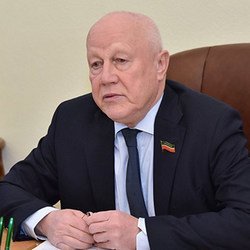‘It is necessary to eliminate the duplication of duties to fight with the army of functionaries’
How Tatarstan is preparing for the next reshuffle in the state administration: after the previous one, the number of positions has increased 2,5 times
This year, Russia’s government intends to cut the army of functionaries that has already reached 2,4 million people, that’s to say, is 2,5 times bigger than the amount of servants in the army and Navy (around a million people). By 1 April, the number of employees of federal ministries is to reduce by 5% and the amount in local agencies — by 10%. So the Cabinet of Ministers hopes to improve the effectiveness of the state administration’s performance. However, despite the cut, the budget won’t save anything — former statesmen’s salaries will be spent to stimulate the rest. As Realnoe Vremya has calculated, up to a billion rubles a year is spent to pay for this “army’s” work (full financial support is up to 6-8 billion rubles every year). At the same time, such reforms aren’t taking place for the first time but often lead to a reverse effect, experts noticed.
How functionaries’ army will get smaller
Russia’s government has decided to cut the army of functionaries again. The state administration’s reform will affect 45 ministries and agencies — 37 deputies are supposed to be laid off.
“Not a huge but rationally created staff of competent specialists and a clearly defined sphere of responsibility of every agency of executive power are needed,” head of the government Mikhail Mishustin commented on the reform.
“A structure where the vice chairperson of a federal agency of executive power supervises a subdivision where only 10 people work can’t operate effectively,” Vice Premier and head of the government’s apparatus Dmitry Grigorenko agreed with him.
By April 2021, 74 subdivisions including those “where only ten people work who are supervised by 37 vice heads of ministries and agencies” are due to disappear. The saved money will stay in payroll budgets and will be redistributed in favour of the rest of functionaries.
Now the number of subdivisions in ministries must be at least 40 positions, 25 people in services and agencies, as many as 5 departments in an office, at least 10 independent departments. A restriction on servicing subdivisions is no more than 30% of the total staff number. In the end, staffs of central apparatuses of federal agencies have started to be laid off by 5% and employees of local agencies by 10% since 1 January.
The first people have already been laid off. So it became known immediately after the January holidays, that Russian Finance Ministry’s First Vice head Tatiana Nesterenko will leave her post, ex-head of the Russian Pension Fund Anton Drozdov will step down as vice finance minister. This is happening because the management of the Ministry of Finance and minister have more deputies than it should be according to new rules — they account for 12, moreover, the Finance Ministry can’t have two first deputies, and one of them had to be laid off or appointed as vice head. As people who are familiar with the laid off personnel says, the high-ranking vices weren’t ready to the reduction in their rank.
State apparatus is reformed once in five years
It is noteworthy that this isn’t the first reshuffle of the state apparatus. Functions of power agencies were supposed to be reduced as early as 2004 together with the number of staff. The saved money was spent to raise salaries, but only for executives. However, they are back to the unsolved problem five years later.
In 2011-2013, it was planned to cut the number of public workers by 20%. However, in 2016, the Accounting Chamber reported on a decrease in the quantity of public servants by 5,6%, which happened because of peripheral workers, whereas the amount of “different kinds of managers”, in contrast, increased.
In 2019, talks about the optimisation were again on the agenda: the staff of central apparatuses of federal agencies of executive power was considered to be reduced by 10%, that of local subdivisions — by 15%. Moreover, due to Dmitry Medvedev’s departure from the Cabinet of Ministers in early 2020 and the subsequent rotation of functionaries, the latter often got “neighbouring” posts in other ministries.
Functionaries’ army only grows despite reforms
Dry numbers of statistics Realnoe Vremya’s analytic staff examined suggest the reforms hardly work, if they do at all. So 691,800 people substituted positions of public civic service, or 42,3% of the total number of workers in these agencies, in public agencies of the Russian Federation at regional level in 2018 (in federal public agencies and public agencies of Russian regions). In 2019, the quantity of public servants at regional level (without central apparatuses) was 688,300 people (91,6% of the capacity). The total amount of people who replaced public posts (civic servants) was 727,500 people in public agencies of the Russian Federation (federal and regional agencies).
Moreover, positions of both federal, regional and municipal officials aren’t a hundred per cent occupied. For instance, the amount of public officials at regional level was 688,300 people by early 2020, the occupancy rate is 91,6%.
As for Tatarstan, in 2018, there were 17,818 public workers, 8,191 of them worked in local agencies of federal power, 4,434 worked in the republic’s agencies of executive power, 5,193 people did in local governments. In 2019, their quantity even increased, but not much, 17,875 people. To compare, only the number of workers in local agencies of federal executive power reduced to 8,181 people, regional workers increased — 4,452 people, the number of municipal employees also grew — to 5,242. In other words, the army of functionaries in Tatarstan didn’t reduce in a year, in fact.
What is more characteristic according to the United Intergovernmental Information and Statistics Service of the Federal Service of Statistics Service, the number of people working in public administration and local governments in Tatarstan is bigger — they were 25,600 people in January 2019. And the Statistics Service suggests that the quantity of functionaries in Tatarstan hasn’t recently fallen but grown. So in January 2018, Tatarstan had 24,468 people in total, a year later, they already amounted to 25,590. In other words, instead of reducing the army of functionaries by 5%, it increased by the 5%.

Up to a billion rubles a year is spent on functionaries’ salaries
The average salary of public officials in Russia’s public agencies in 2019 was 60,200 rubles. Workers in central apparatuses of federal public agencies had the highest salary — 140,000 rubles. The average monthly salary of public workers in regions was just 55,700 rubles. The wage in federal public agencies totalled 49,900 rubles, public agencies of Russian regions was 69,400 rubles. While the monthly average salary of municipal workers made up just 45,500 rubles.
If we believe the latest statistics, functionaries’ salaries were partly cut in 2020: so the average monthly wage of workers in public administration and local governments in Russia’s regions was 53,900 rubles as of 1 November. Moreover, the salary in Tatarstan was 45,500 rubles (43,400 a year ago). However, the state apparatus itself absorbed nearly 6 billion rubles from the budget as of 1 November 2020 (it was planned that the total annual expenses would be 9 billion rubles, but it seems the pandemic and forced social distancing cut functionaries’ costs). A billion rubles from this sum was spent to pay salaries to all Russian functionaries. In 2018-2019, costs on functionaries amounted to 7,8bn rubles every year.
“They proliferate”: how number of responsibilities increased 2,5 times after personnel reforms

“For instance, we have our structure, the ministry, and at the same time there is a similar federal supervising structure. If they could be united, it would be useful both for the federal centre and the republic,” Galeyev assumed. “And here one should take a broad view. Initiatives of reducing the apparatus of functionaries by 10% appear from time to time, around once in five years. We can see the result. The so-called administrative reform was made up in 2004-2005 at federal level. A three-level management system was envisaged. Then all public positions — Dmitry Kozak chaired this work — were counted for the first time, they amounted to 5,500 (only at federal level!). So now, 15 years later, these public positions total 13,500! They have increased 2,5 times! This is the result of the work when reforms on the reduction of the number of functionaries by 10% were initiated every five years. They proliferate. To fight this, it is necessary not to reduce the staff but eradicate many duties and eradicate the duplication of duties at federal and regional level.”
“This didn’t happen even in the Soviet era”
The deputy thinks it is impossible to fight the big amount of functionaries by cutting the payroll budget because this would “contradict any legislation on public service”, at least, law had to be changed. Marat Galeyev assures that the only productive way is to “cancel many public functions when we talk about unnecessary functions”. Moreover, the deputy suggests that such a problem didn’t exist in the Soviet era:
“At federal level, there is a function of control. This didn’t happen even in the Soviet era. In the USSR, everything was done in one agency — general public and republican duties. For instance, the Finance Ministry of the TASSR performed functions successfully despite the existence of the parallel USSR Ministry of Finance that allocated federal money. Then everything was divided, and there was a problem of unlimited growth of different duties.”